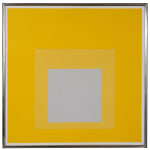


Josef Albers German-American, 1888-1976
24 x 24
Further images
“Color has a magic power.”
Josef Albers, 1952
In the work Study for Homage to the Square: Decided Josef Albers demonstrates a mastery of color and form. This incandescent composition dates from the artist's most celebrated Homage to the Square series in which he methodically examined the process of perceiving and experiencing color.
Josef Albers was a passionate teacher. Co-director with Laszlo Moholy-Nagy of the preliminary course at the Bauhaus school for 13 years, then teacher at Black Mountain College in North Carolina and finally at Yale University from 1950, he always cultivated in parallel his artistic practice, particularly photography and painting, on glass at first. It was the year he arrived at Yale in 1950 that Albers painted the first "Homage to the Square". He worked on the series tirelessly for twenty-six years, until his death in 1976. Through his teaching and his works, he left a deep imprint on the history of art.
Albers apprehends color from the perspective of its sensory appearance and brings out its own materiality. For each of the Homage to the Square works within his series, Albers showcased precisely composed squares of color, balanced one inside the other, on square masonite panels. This type of composition and format allowed the artist to examine color relationships, and their emotive and psychological impact, in a structured and stable capacity.
Albers goes beyond composition and format, which had previously seemed fundamental to painting. It allows him to devote his practice to the real subject of his work: color. He uses the square as a mean to explore it: how they relate to each other and, more precisely, how their juxtaposition affects the perception of the human eye.
The series "Homage to the square" is both a demonstration of the interaction of colors and a lesson, but also an object of pure aesthetic contemplation.
“We are able to hear a single tone. But we almost never (that is, without special devices) see a single color and unrelated to other colors.
Colors present themselves in continuous flux, constantly related to changing neighbors and changing conditions"
(J. Albers, Interaction of Color, New Haven, 1971, p. 5)
The square is of course not chosen by chance, the optical effects created by the contrasting flat tints of his palette are reinforced by the geometric shape of the square. Also, Albers offsets the central square downward, which activates the effect of the impression of movement of the forms.
He thus methodically examines the process of color perception. These explorations of color theory and the pure aesthetics of his work have cemented Josef Albers' prominent place in the canon of art history and his lasting impact on generations of artists to come.
“To make you doing creative seeing of colors, this is my real aim” (Josef Albers)
In Study for Homage to the Square: Decided, rich and very distinct yellow and gray hues confront and tame each other. This application of color makes it question the mechanics of the optical system. The geometry of the intermediate square seems to withdraw to let the outer square and the central square move forward, the central square seems almost to extract itself from the plane. This dynamism creates a momentum towards the viewer.
Each painting is unique and can be understood as such, but this series can also be understood as a whole, each color interacts with each other and the paintings interact with each other.
The works of Josef Albers are of a remarkable workmanship. He coats the Masonite (reconstituted wood) plates with several layers of white gesso, sketches the squares and then applies the colors with a palette knife. He works from the inside square to the outside, without ruler or tape. It is a thoughtful, calm, repetitive, almost artisanal way of painting. Albers gave a double meaning to the vocation of painting: a simple craft work and a spiritual calling. Albers' paintings are extremely rational constructions, pure statements of visual logic that evoke the classical, the absolute and the timeless.
By the 1960s, a new look was taken at Albers' work, which until then had been admired primarily for his teaching work. The young generation of American artists worked on comparable themes to his and found themselves in the rational approach of Albers' work. These young artists would soon identify themselves under the banner of Minimal Art, turning away from abstract expressionism. Among these artists are Donald Judd, Sol Lewitt, Dan Flavin...
Provenance
Galerie Ernst Beyeler Basel (acquired from the artist in April 1972)
Galerie Melki, Paris (acquired in 1973)
Private Collection (acquired from the above in 1973)
Sotheby's, New York, November 9, 1982, lot 21B
Private Collection
Hollis Taggart Galleries, New York (acquired in 2016)
Private Collection
Phillips New York, 20th Century & Contemporary Art Day Sale, 15 November 2017 (Lot 117).
Private collection
Exhibitions
Northampton, Smith College Museum of Art, An Exhibition of the Works of Josef Albers, February 5 -23, 1964



